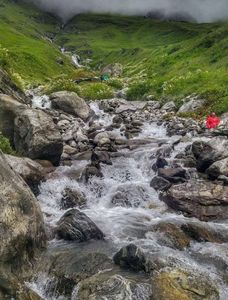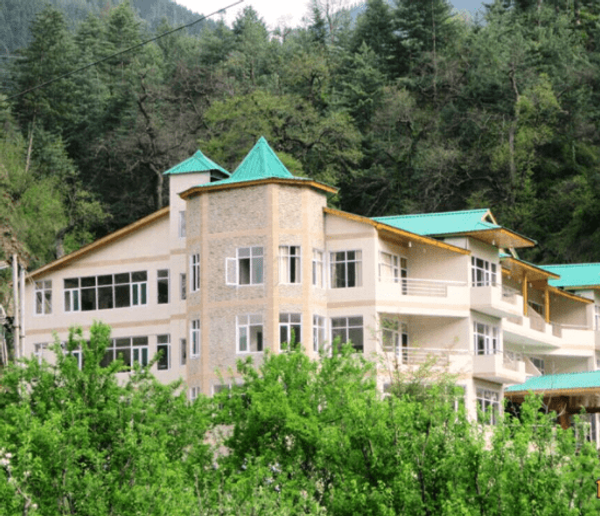Pushpavati River and Its Role in the Blooming Marvel of Valley of Flowers
 Deepanshu Negi
28 Jul, 2025
9 mins read
0
Deepanshu Negi
28 Jul, 2025
9 mins read
0

Nestled high in the Western Himalayas of Uttarakhand, India, the Valley of Flowers is a place that looks straight out of a dream. Every year, this valley transforms into a vibrant carpet of blooming flowers, attracting nature lovers, trekkers, and botanists from around the world. But behind this stunning natural display lies a quiet hero the Pushpavati River.
This river might not be as famous as the Ganges or Yamuna, but its role in shaping the beauty and life of the Valley of Flowers is nothing short of essential. In this article, we’ll explore where the Pushpavati River comes from, how it flows through the valley, and why it plays such a crucial role in keeping the valley alive and thriving.
Where Does the Pushpavati River Come From?
The Pushpavati River begins its journey from the Tipra Glacier, which lies close to the Nilgiri Parvat and Rataban peaks, at an altitude of over 5,000 meters. This glacial origin means that the river is fed by melting snow and ice, especially during the warmer summer months.
As the snow melts in the higher regions, water flows down to form small streams. These streams come together to give birth to the Pushpavati. It starts as a clear, icy cold river and flows down into the Valley of Flowers, weaving its way through rocky terrain, green meadows, and eventually dense fields of blooming wildflowers.
The River’s Journey Through the Valley
As the Pushpavati River enters the Valley of Flowers, it becomes the lifeline of this UNESCO World Heritage Site. The valley itself lies at an altitude of around 3,500 meters and is spread across 87 square kilometers.
The river doesn’t just cut through the valley; it breathes life into it. Its presence ensures that the soil stays moist, even during dry spells. This moisture is critical for the growth of over 500 species of alpine flowers, many of which are rare or endangered.
The valley blooms mostly from June to September, right after the snow starts melting. This timing perfectly aligns with the river’s peak flow. As the water level rises with the melting snow, it spreads across the valley, soaking the soil and feeding underground water reserves.
How Pushpavati Helps the Flowers Bloom
The blooming of flowers in the valley is not just about sunlight and altitude. Moisture and minerals from the river play a huge role. As the Pushpavati flows through the mountains, it picks up nutrients from rocks and glaciers. These minerals enrich the soil in the valley, making it fertile and suitable for many types of plants.
Additionally, the river helps regulate the valley’s micro-climate. Even though the valley is surrounded by snow-covered peaks, the river ensures that the temperature remains just right for flowering plants to thrive. The cool mist from the river can even create a gentle fog in the early morning, keeping the valley humid and fresh.
Without the Pushpavati, the Valley of Flowers would likely be a dry, rocky highland with little vegetation. It is the steady flow of clean, mineral-rich water that transforms it into a paradise of colors.
A Natural Drainage System
The Pushpavati also plays an important role in draining excess rainwater from the valley. During the monsoon season, the valley receives heavy rainfall, and without proper drainage, the soil could erode, and landslides could occur.
Thanks to the Pushpavati and its network of small tributaries, rainwater is quickly carried away, reducing the risk of waterlogging or damage to the fragile ecosystem. This natural drainage system helps protect both the flowers and the pathways that trekkers use to explore the valley.
Role in Supporting Wildlife
The Valley of Flowers is home to several species of animals and birds, including the blue sheep, Himalayan monal, snow leopard, and Asiatic black bear. These animals depend on the valley’s water sources, especially the Pushpavati, for drinking water and habitat.
The river also supports the growth of grass and shrubs, which serve as food for herbivores. In turn, predators depend on these herbivores, creating a balanced food chain. In short, the Pushpavati is not just supporting flowers but the entire wildlife system of the region.
Cultural and Mythological Significance
Like many rivers in India, the Pushpavati holds a place in local stories and beliefs. Some legends say that the river was named after a divine maiden named Pushpavati, who turned into a stream of flowers. While this is just folklore, it reflects the spiritual connection that locals feel with their land and rivers.
For many trekkers and pilgrims, visiting the Pushpavati is a peaceful and even spiritual experience. The sound of its flowing waters, combined with the sight of blooming flowers and towering mountains, leaves a lasting impression.
Challenges and Conservation
Unfortunately, like many other natural sites, the Valley of Flowers and the Pushpavati River face environmental threats. Climate change is affecting glacier melt patterns, which could impact the river’s flow in the future. Uncontrolled tourism, plastic waste, and human interference are also concerns.
The Forest Department of Uttarakhand, along with UNESCO, has taken steps to protect the valley. Entry is limited, camping is banned inside the valley, and all visitors are expected to follow strict rules. These efforts are aimed at ensuring that the Pushpavati River continues to feed the valley for generations to come.
The Trek to Pushpavati and Valley of Flowers
Reaching the Valley of Flowers involves a trek of about 17 kilometers from Govindghat via Ghangaria. Along the way, trekkers often cross wooden bridges over the Pushpavati River, especially near the entrance to the valley.
These bridges offer some of the best views of the river. You can see it tumbling down rocks, curving through meadows, and sometimes disappearing into thick patches of flowers. It’s one of those rare moments where nature shows you how connected everything really is.
Final Thoughts
The Pushpavati River might not have the fame of larger Indian rivers, but its role in creating and sustaining the Valley of Flowers cannot be overstated. It nourishes the soil, supports life, prevents erosion, and adds to the beauty of one of India’s most magical places.
If you ever get the chance to visit the Valley of Flowers, take a moment to appreciate the river that makes it all possible. The sight of the Pushpavati quietly flowing through a sea of blossoms is a gentle reminder of how nature’s smallest forces often create the biggest wonders.
Written By:
Deepanshu Negi



Hotels at your convenience
Now choose your stay according to your preference. From finding a place for your dream destination or a mere weekend getaway to business accommodations or brief stay, we have got you covered. Explore hotels as per your mood.





